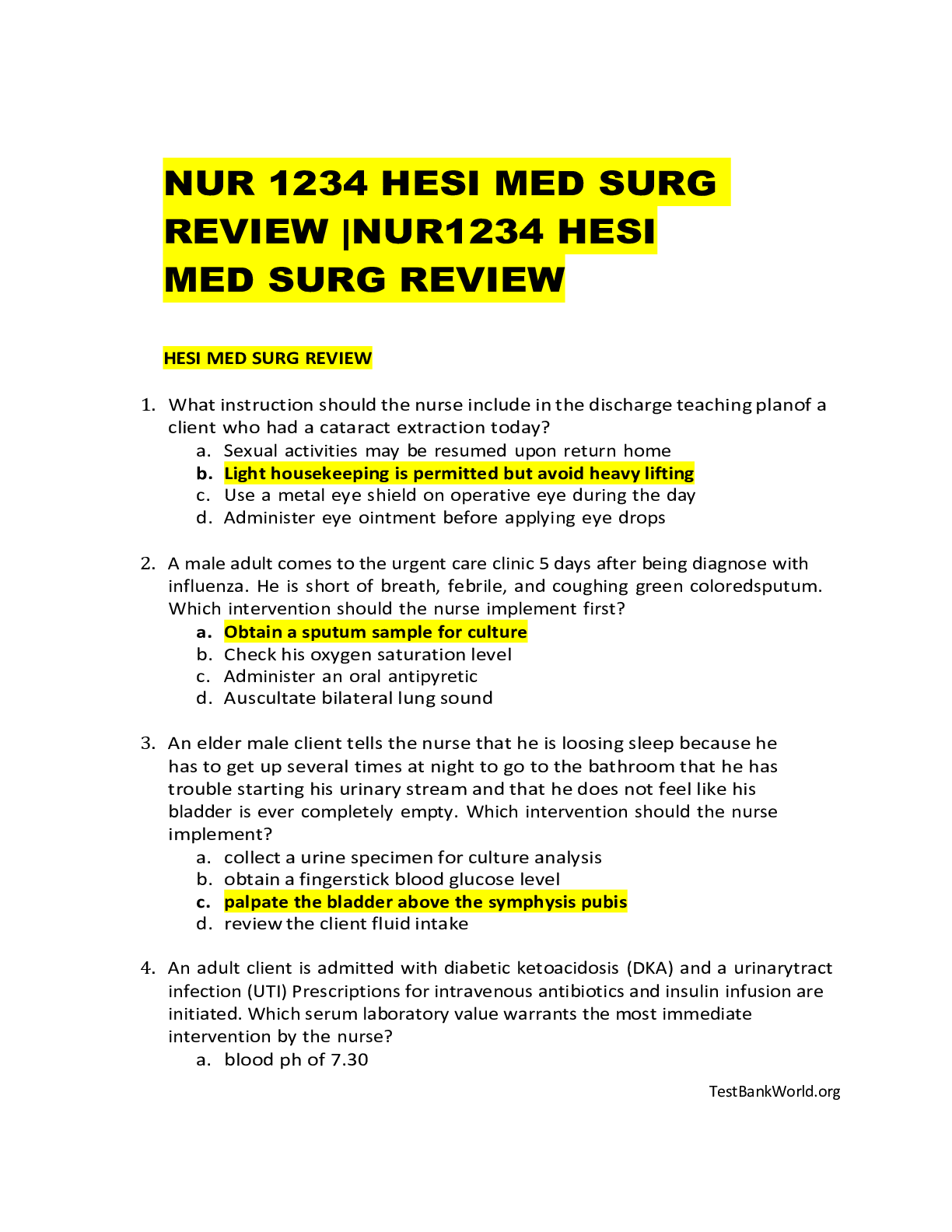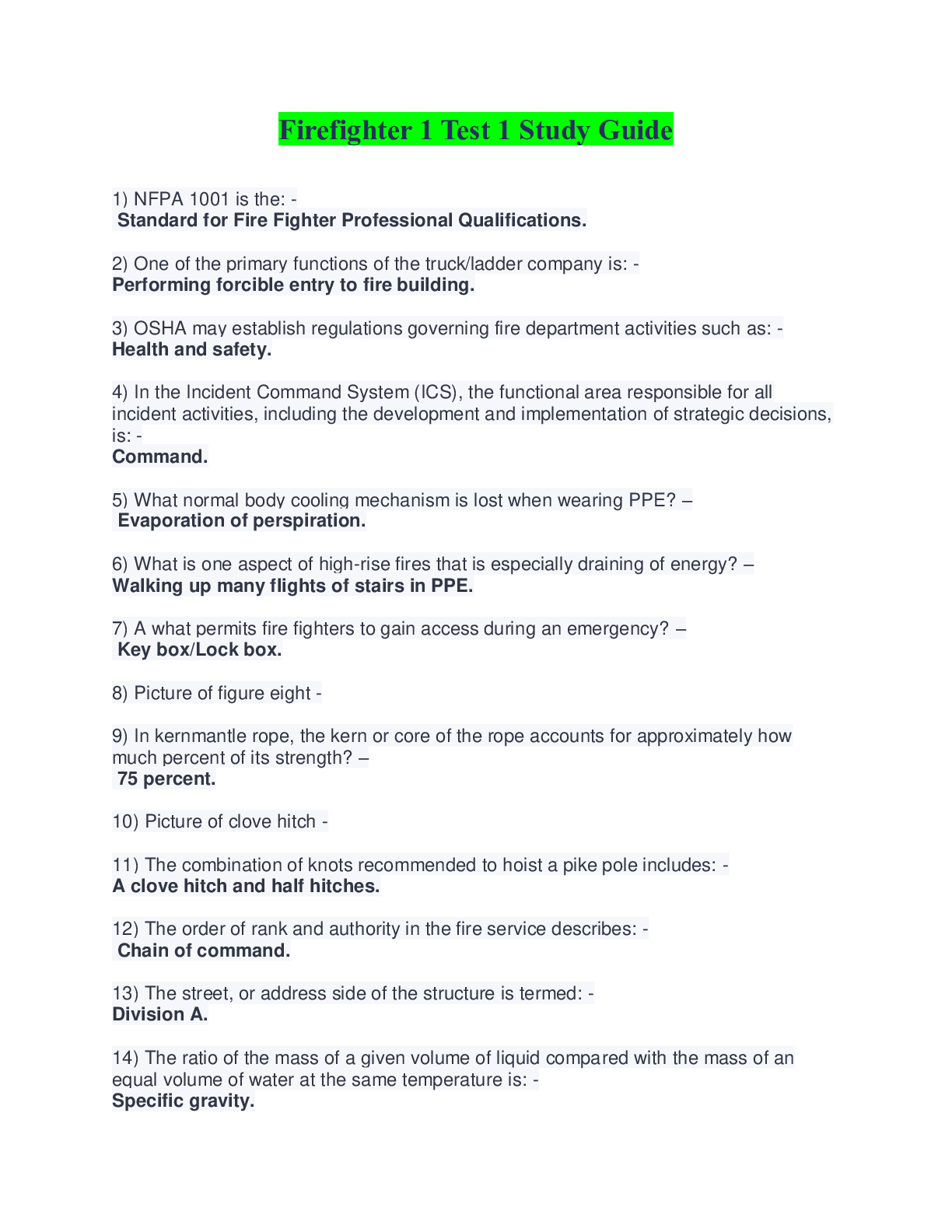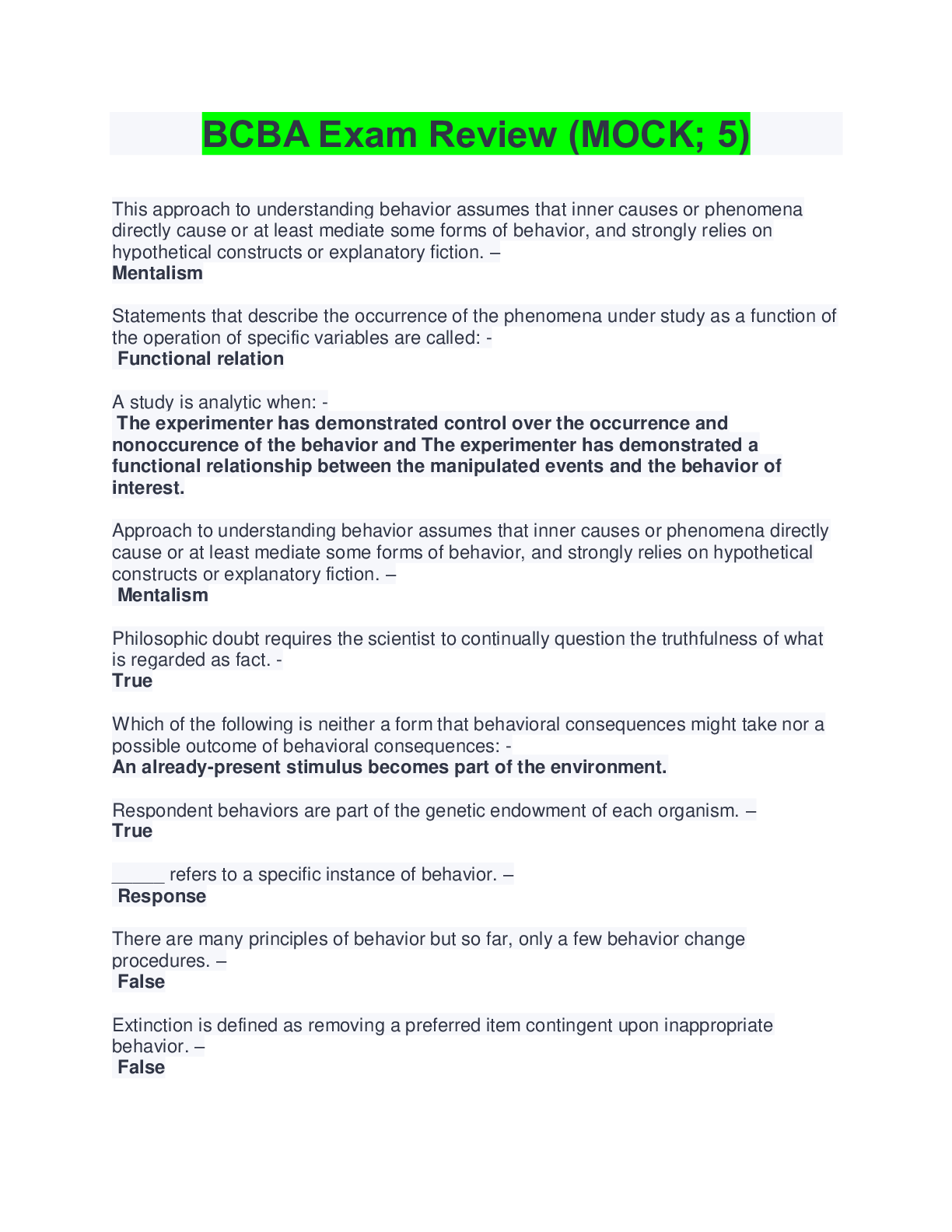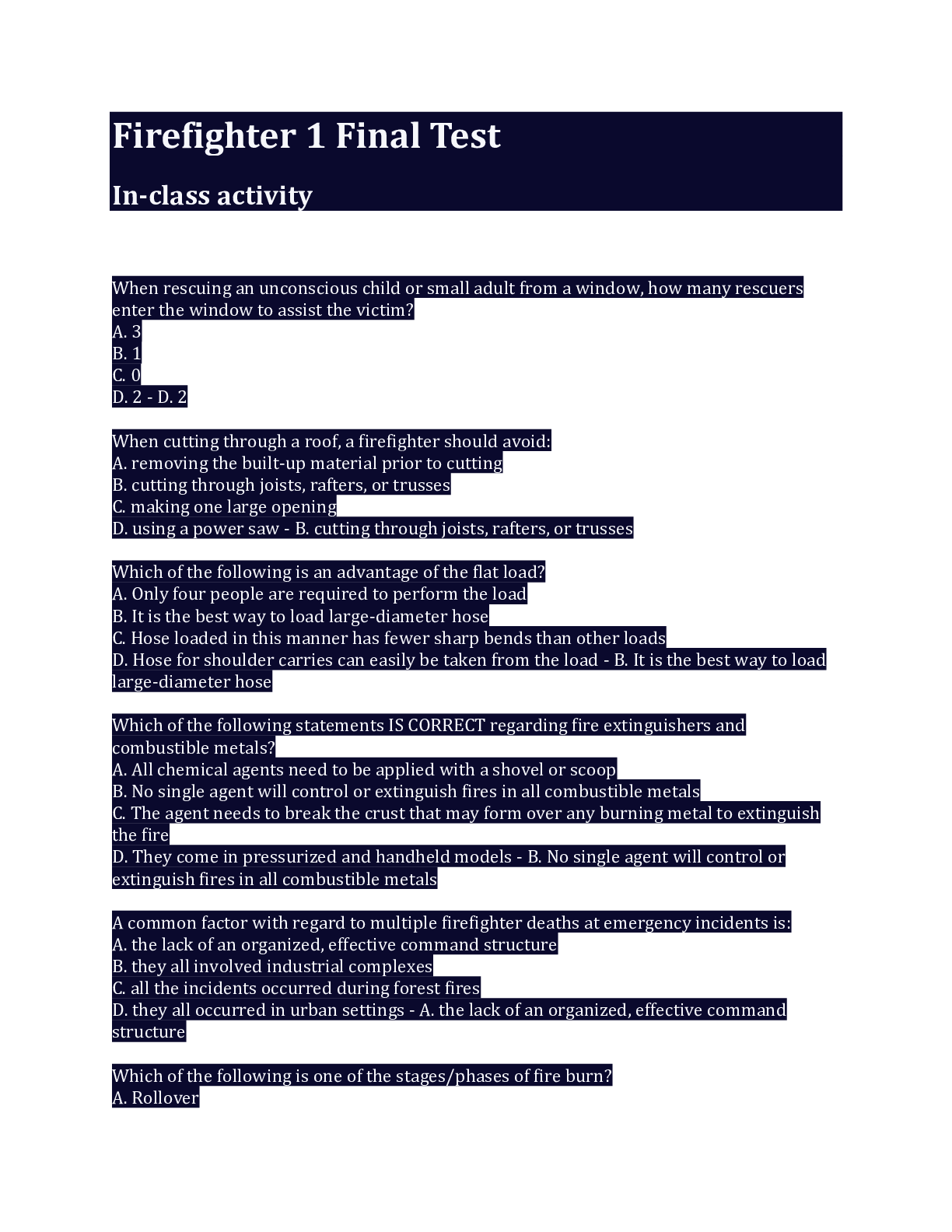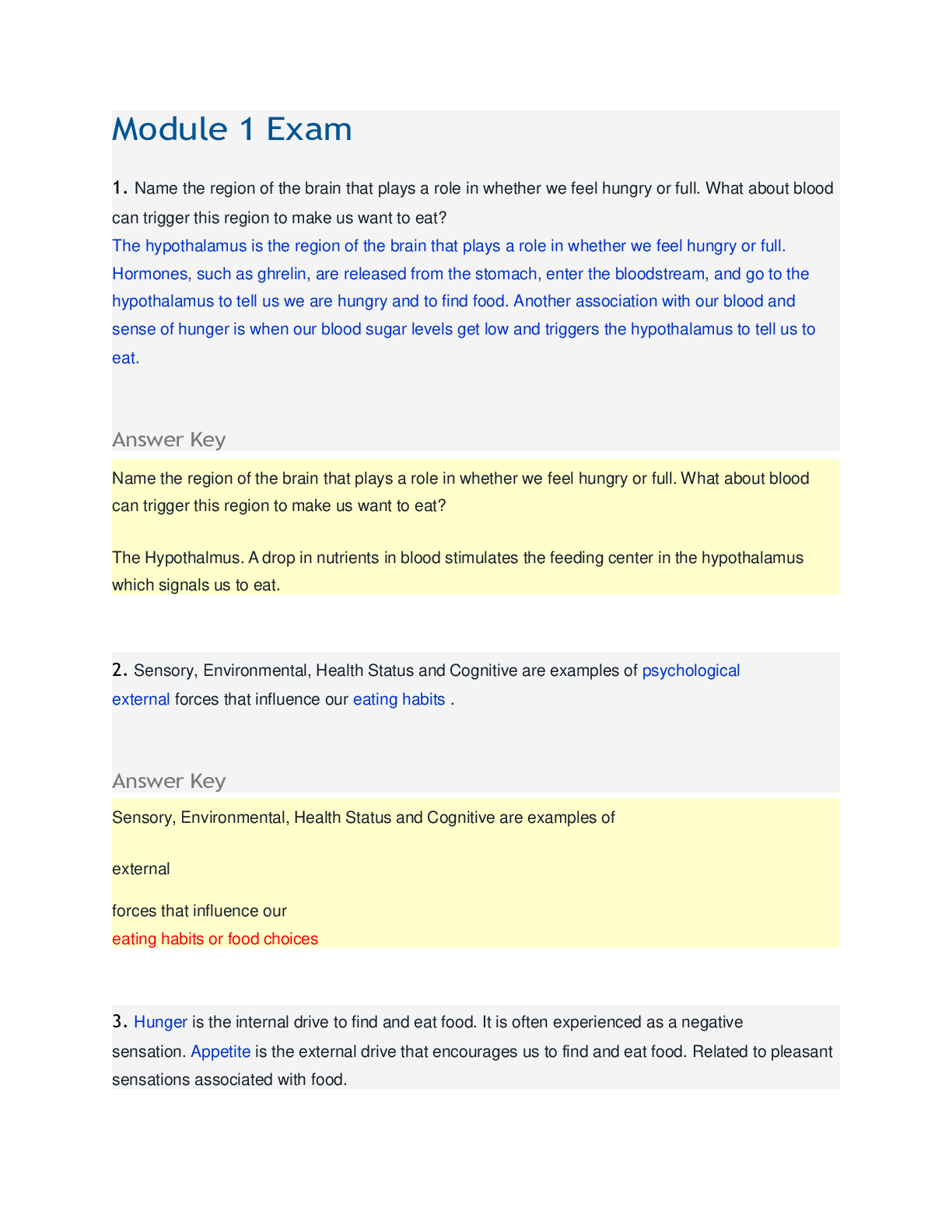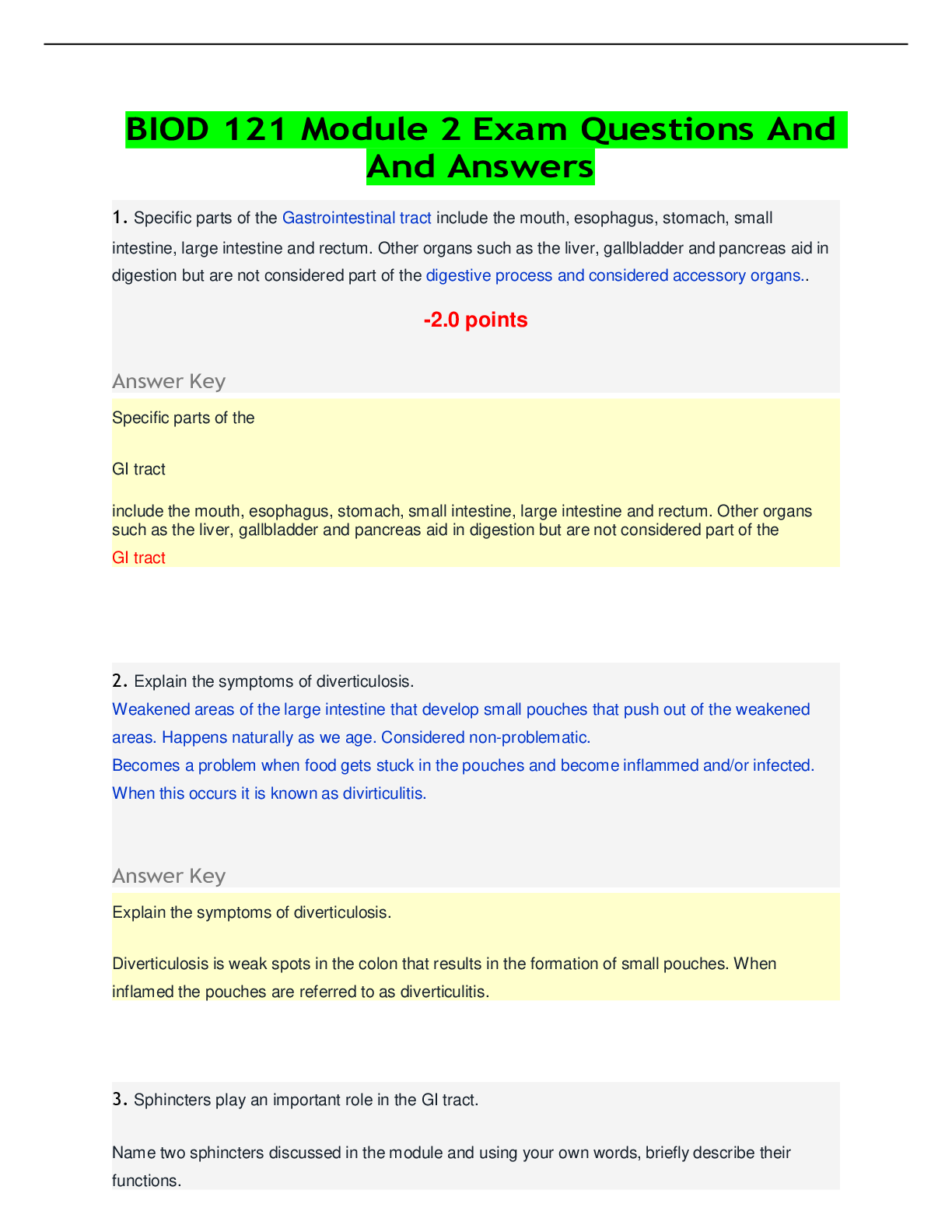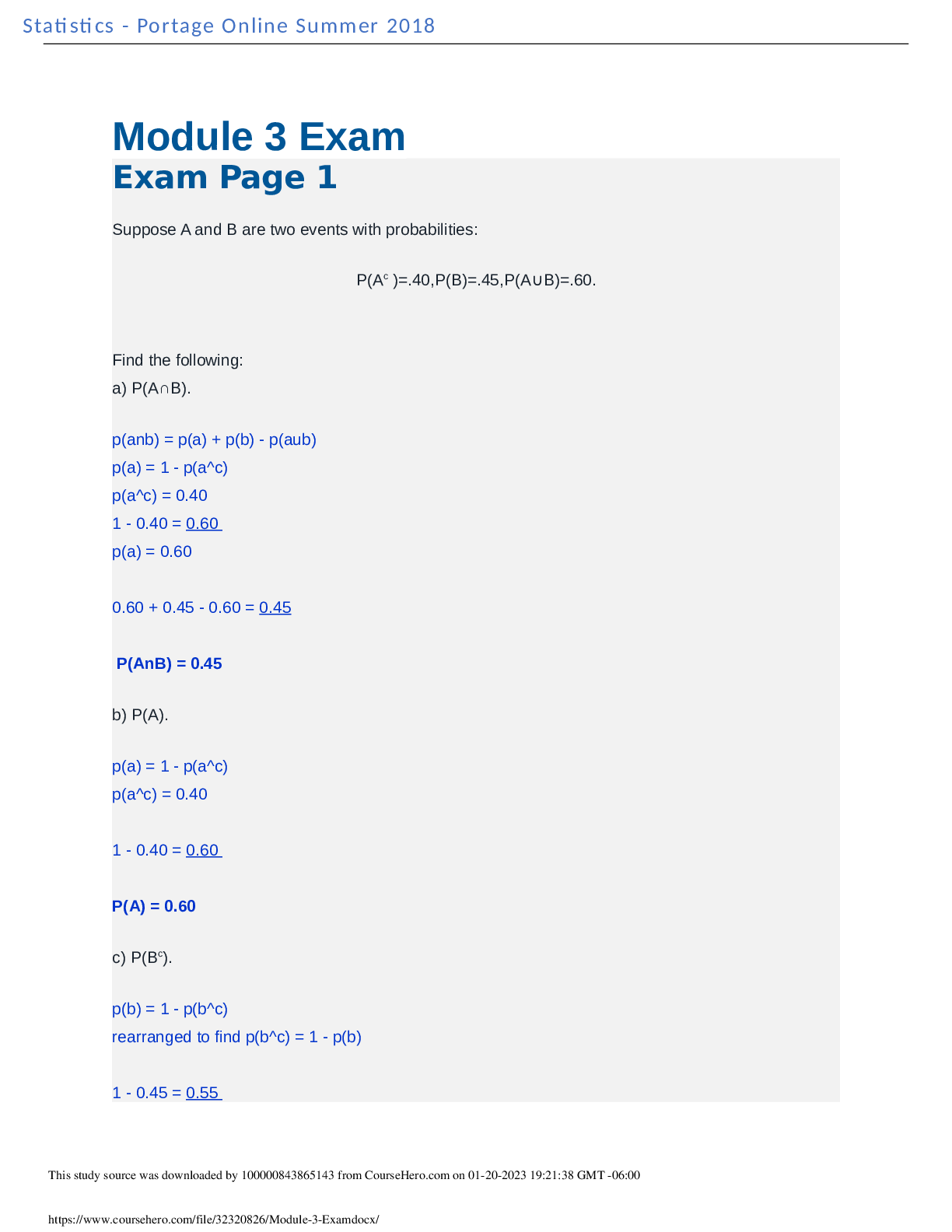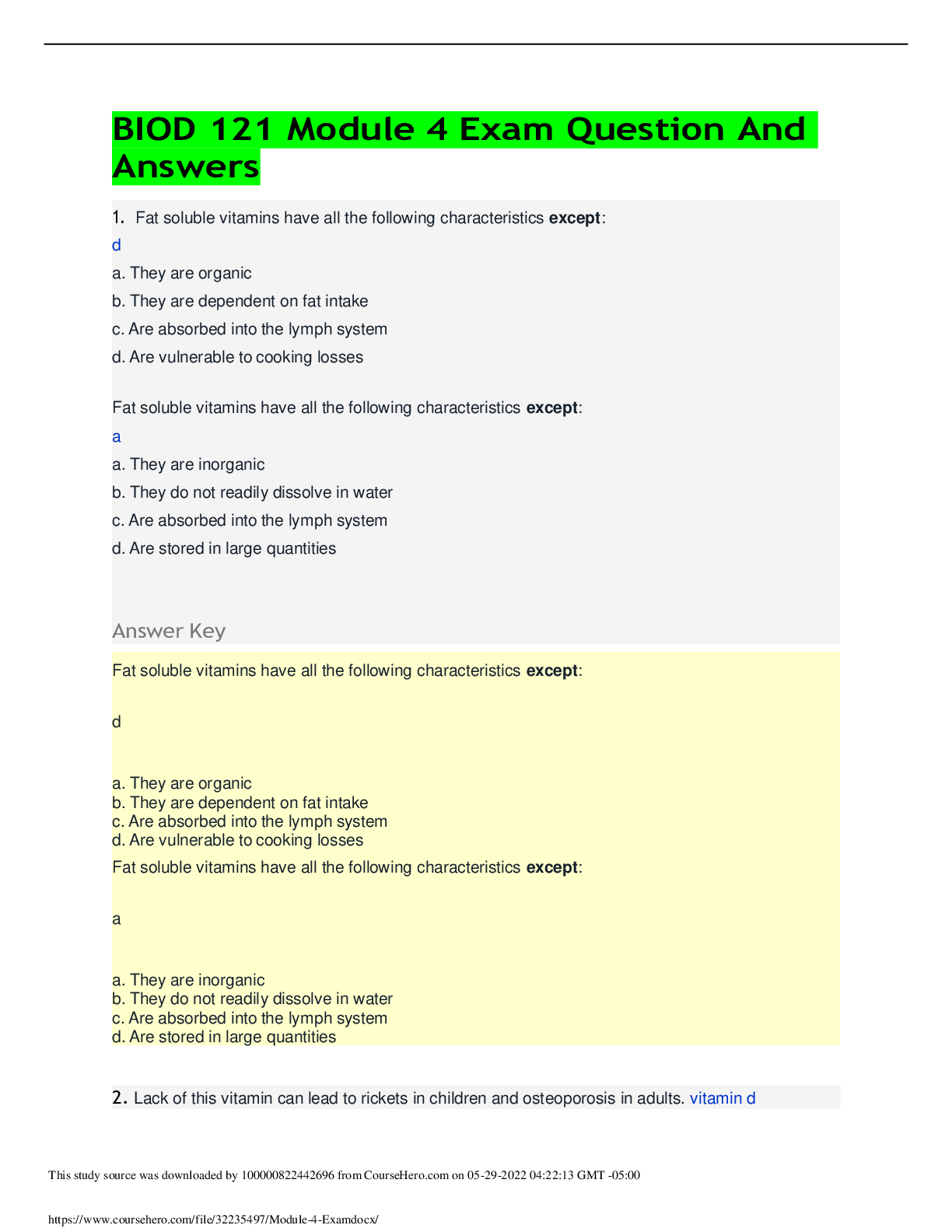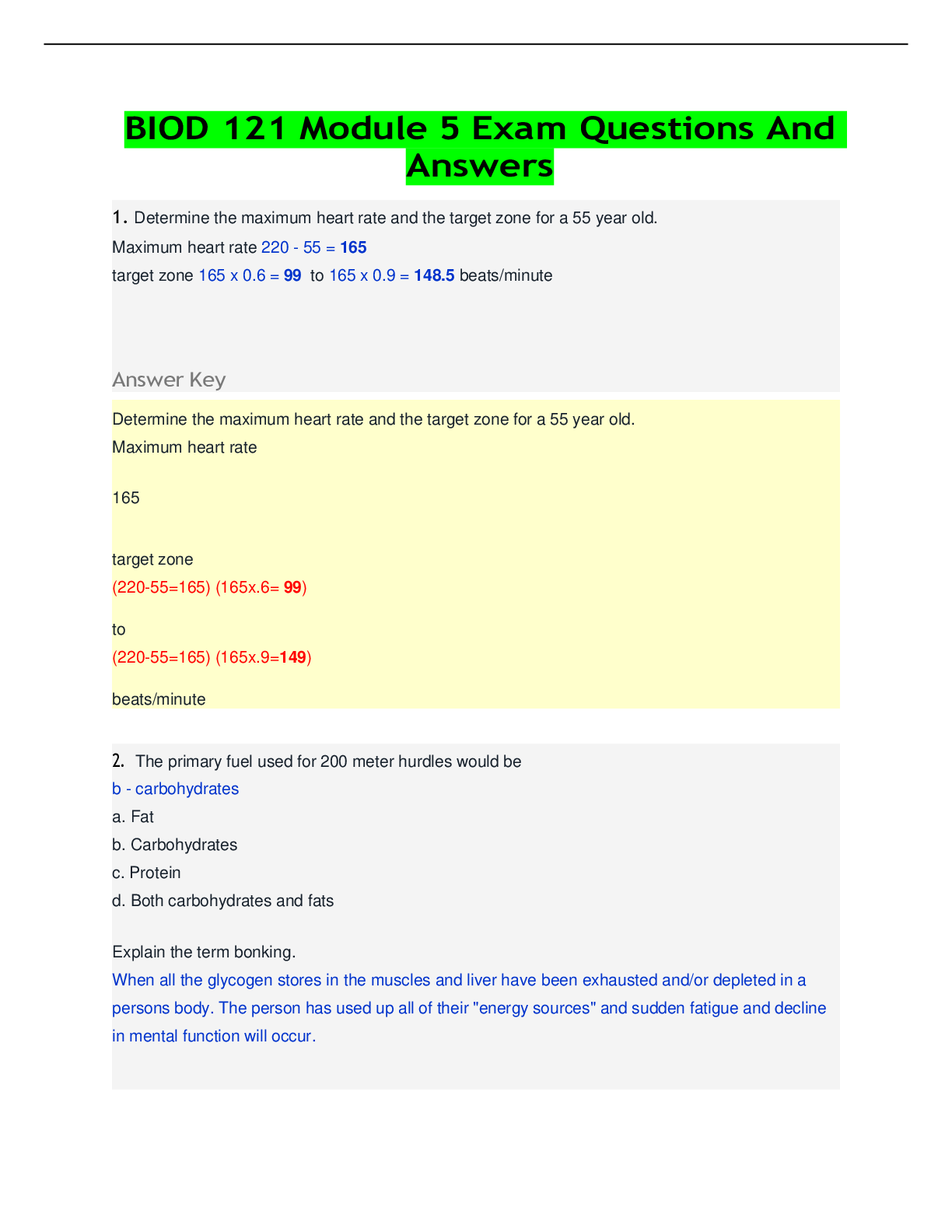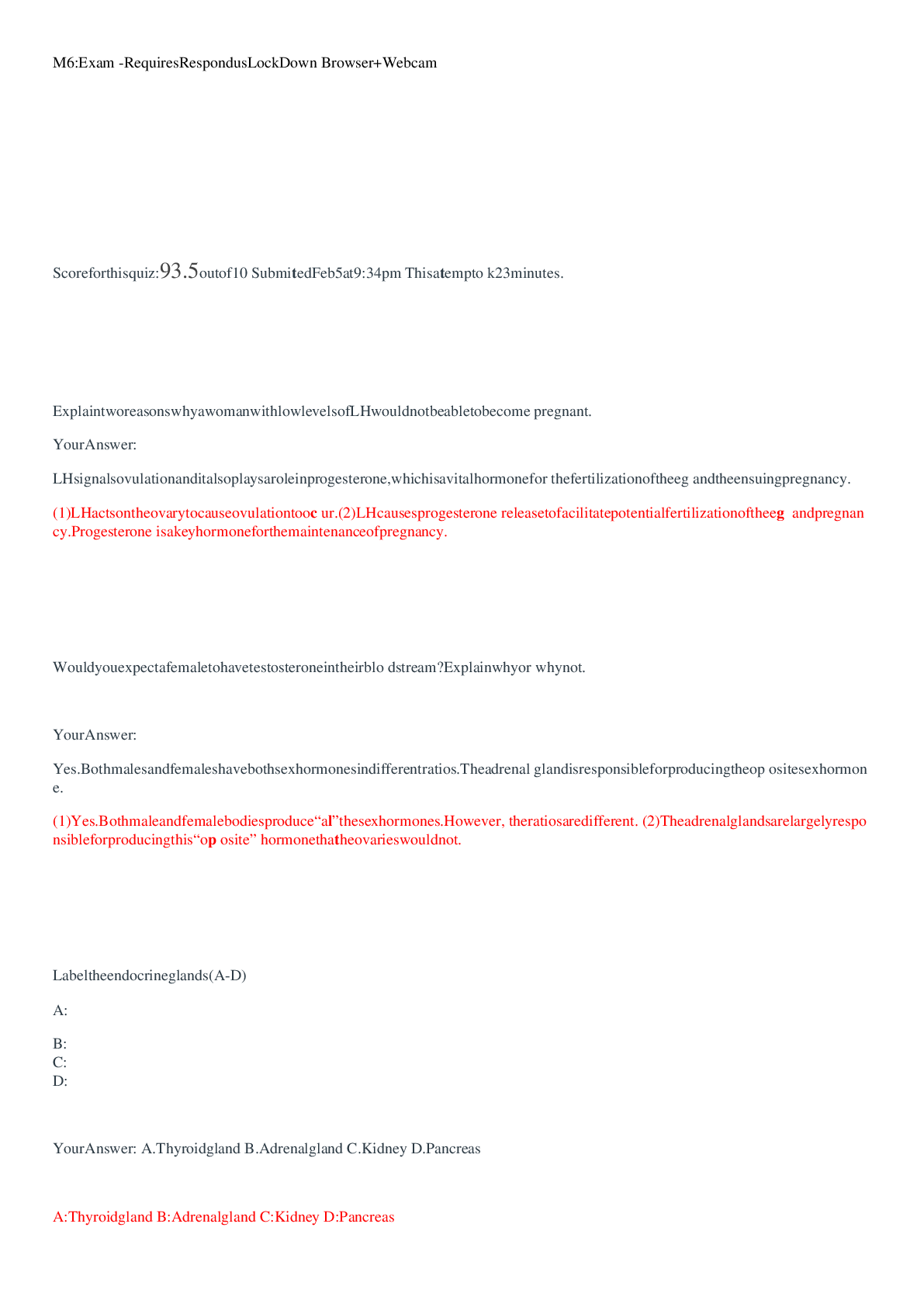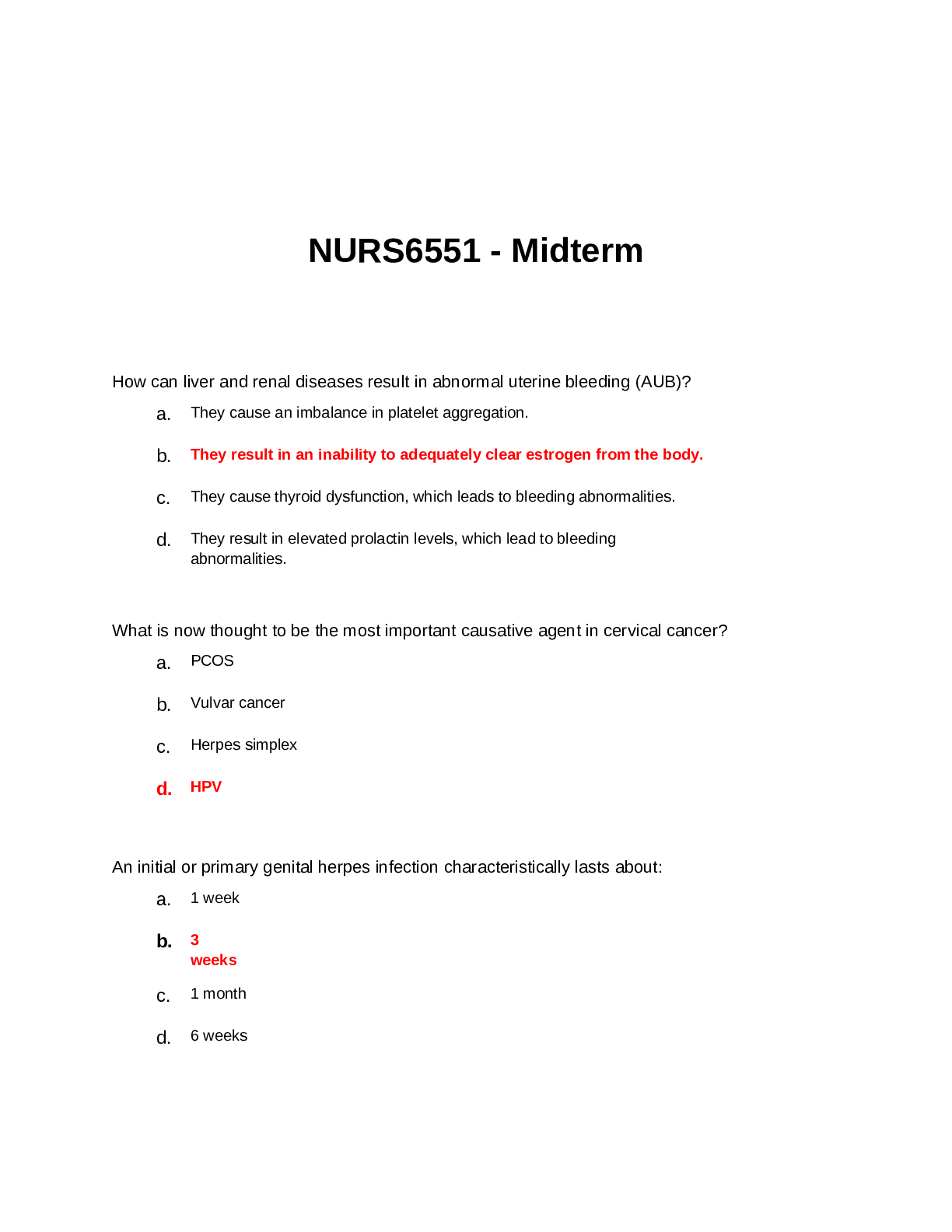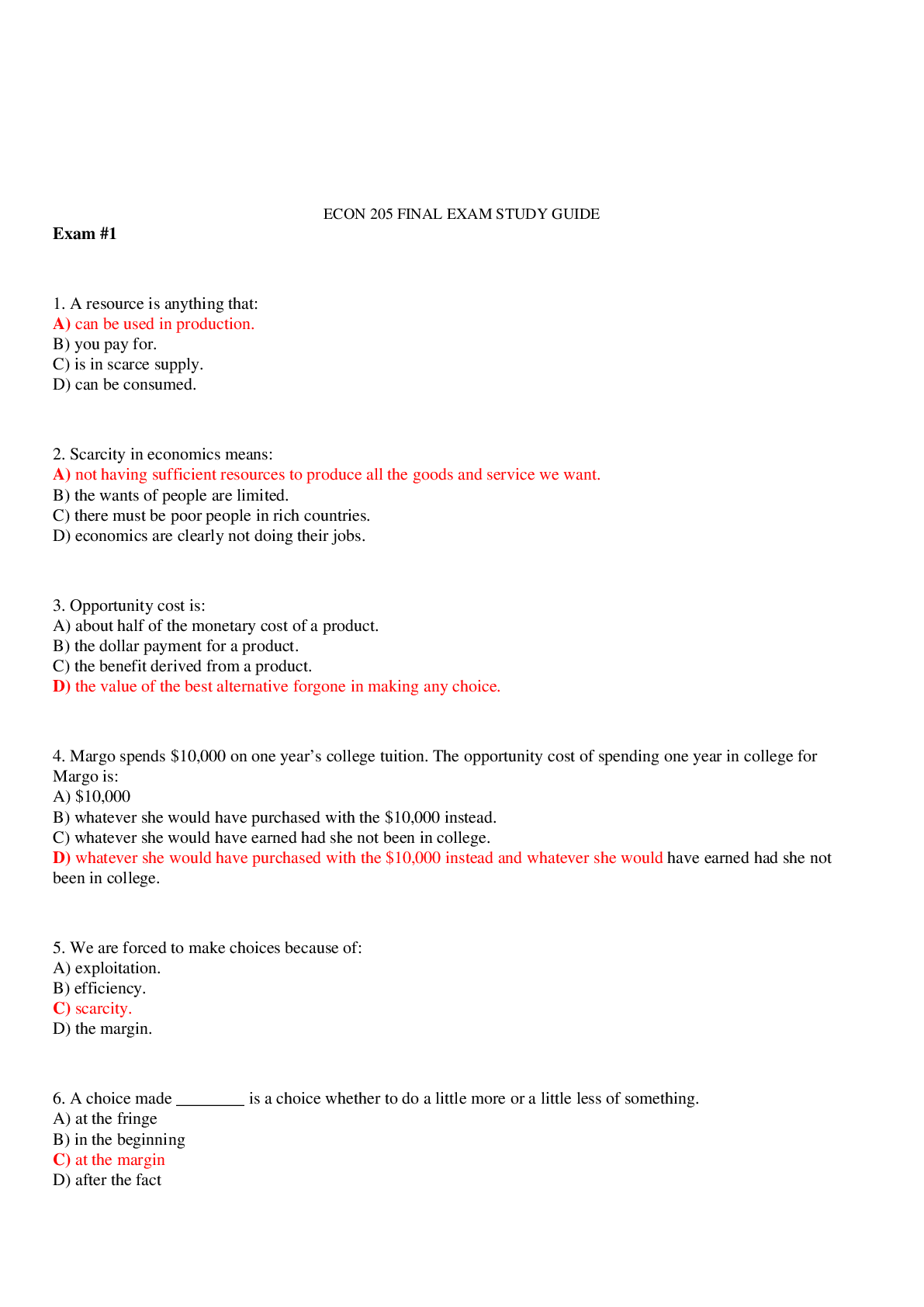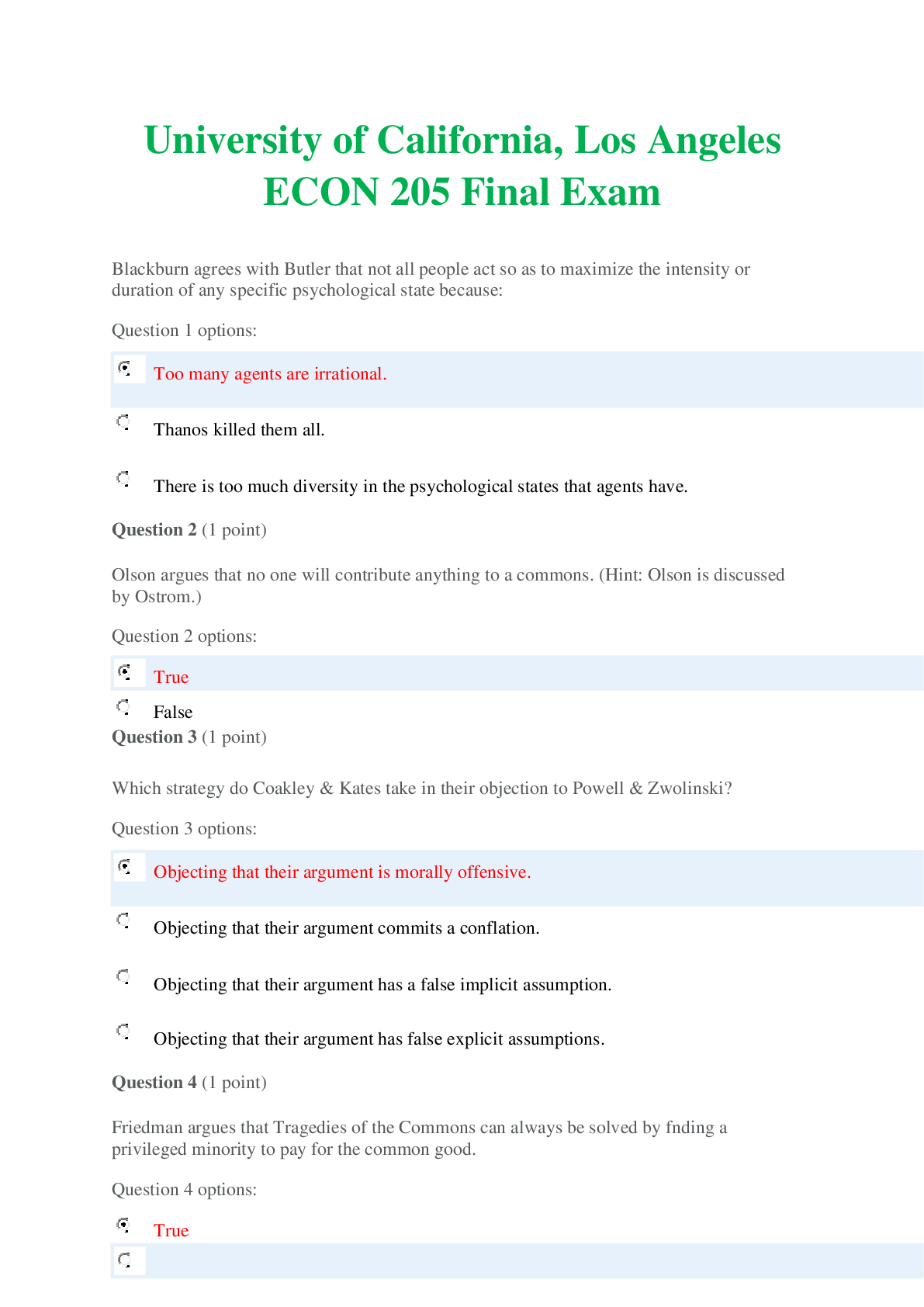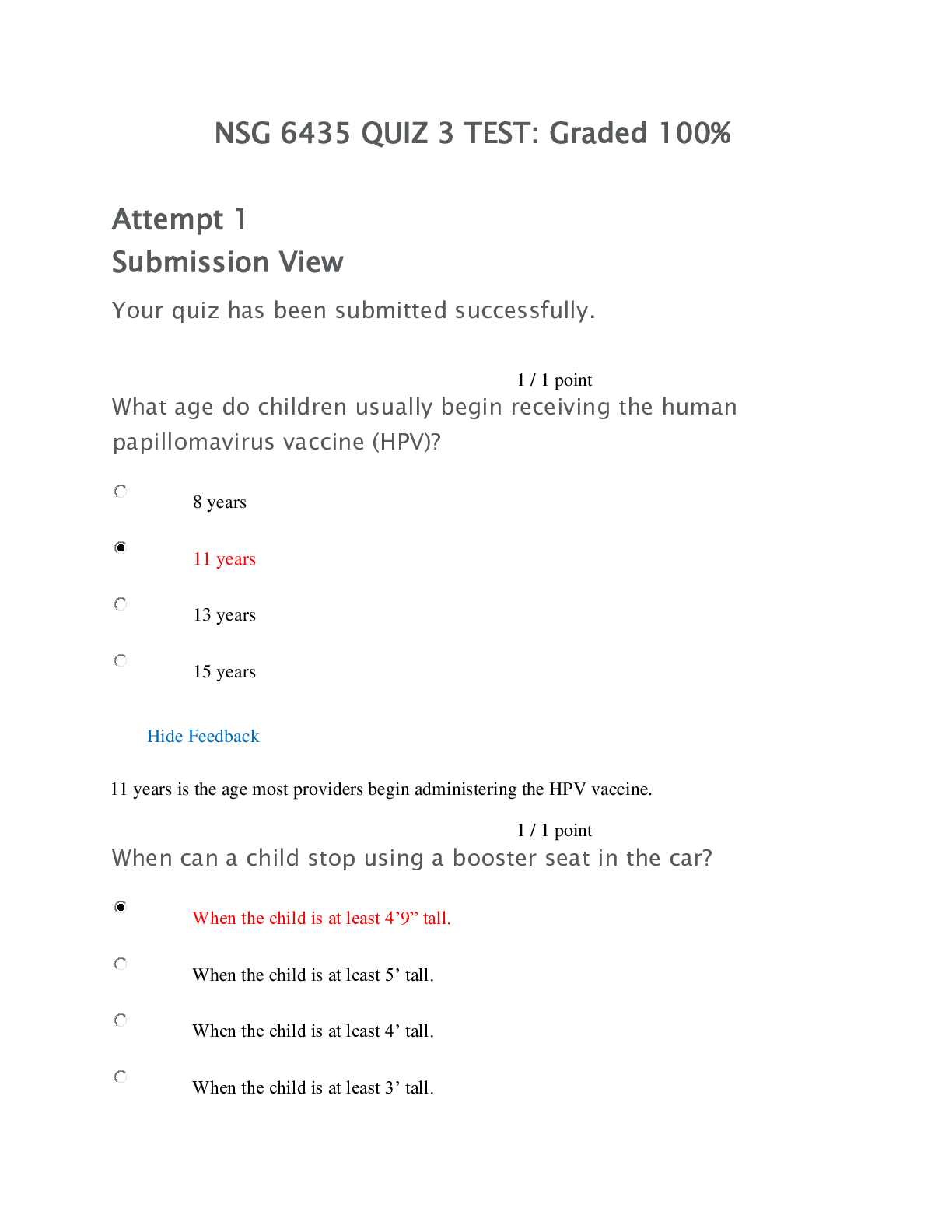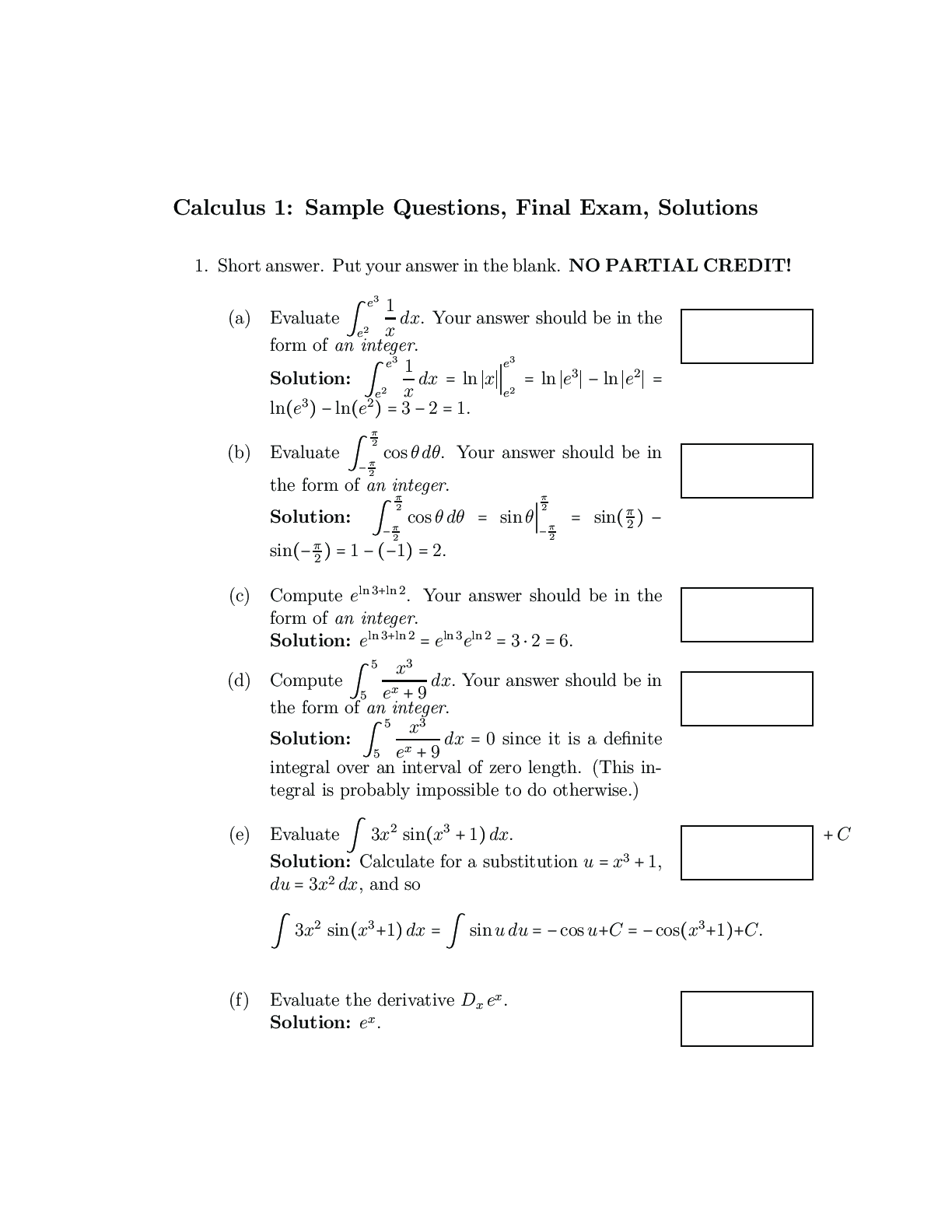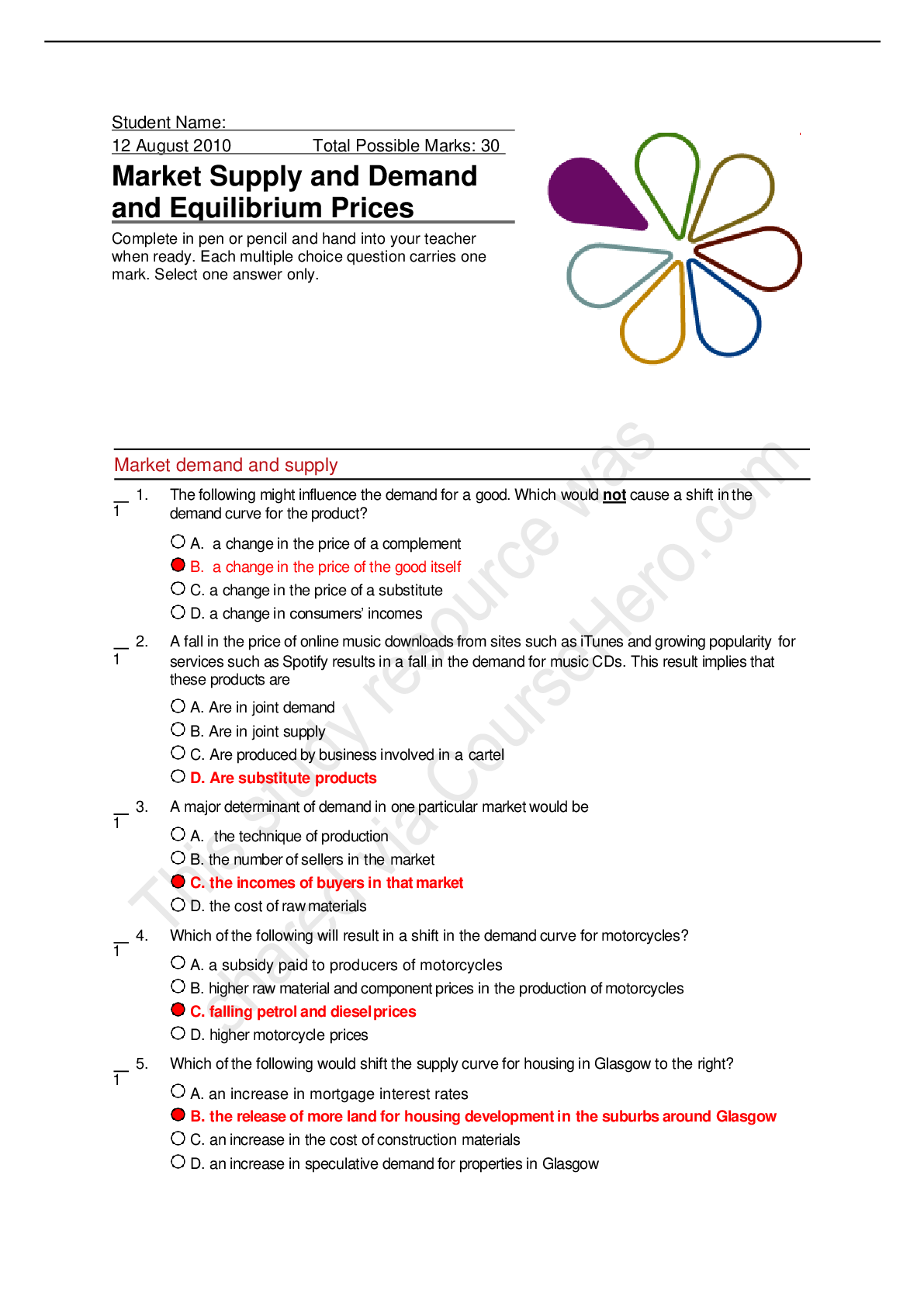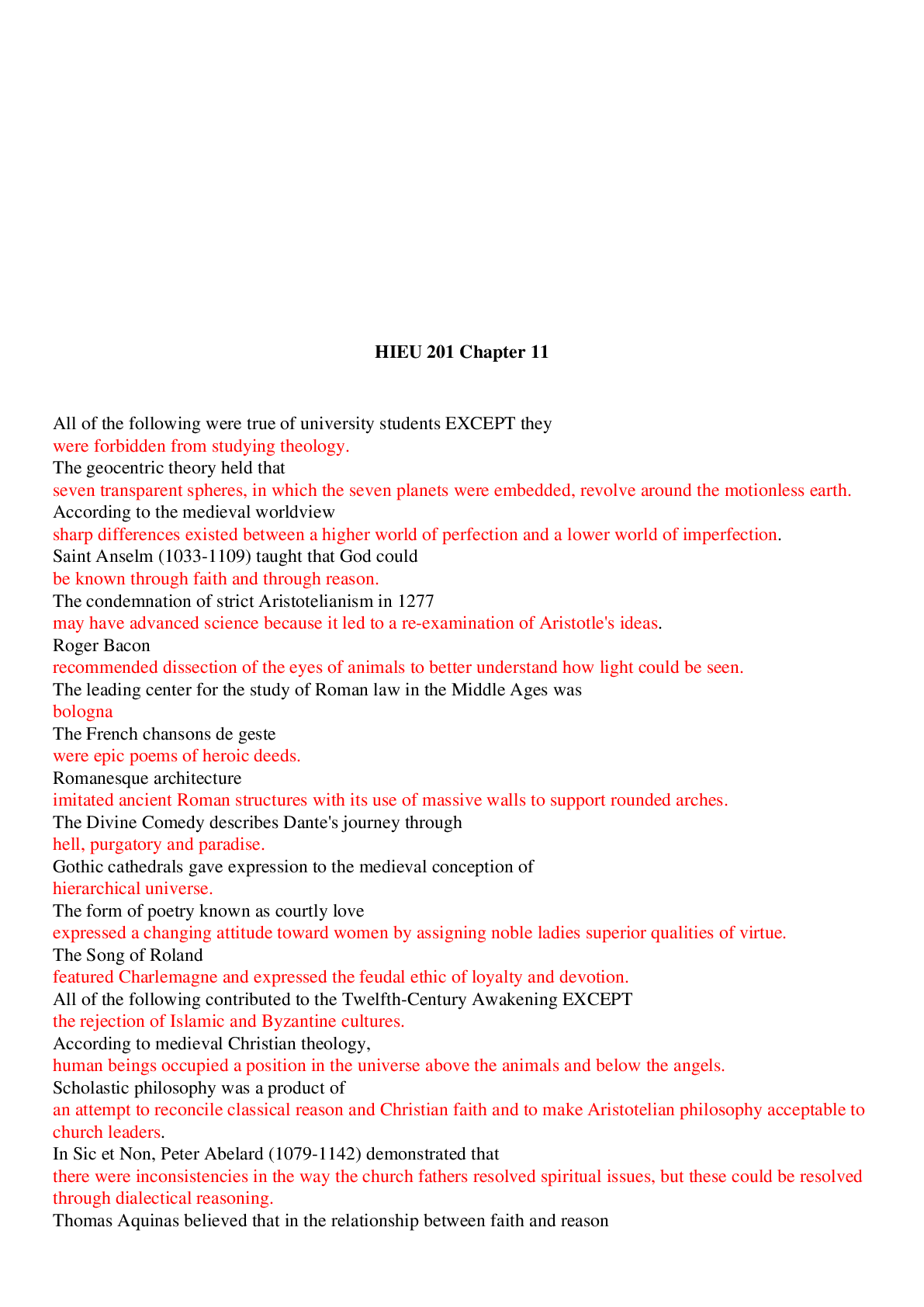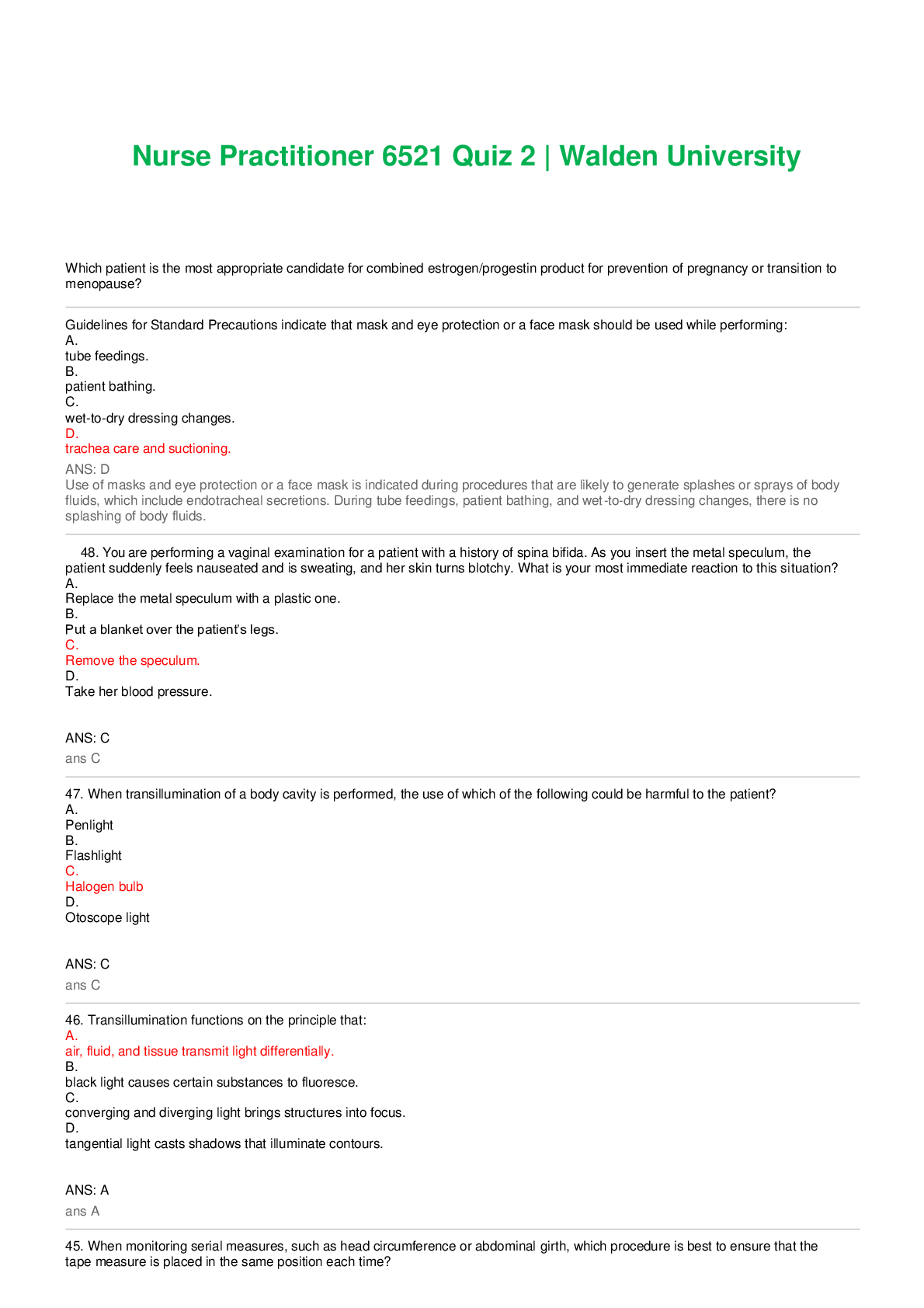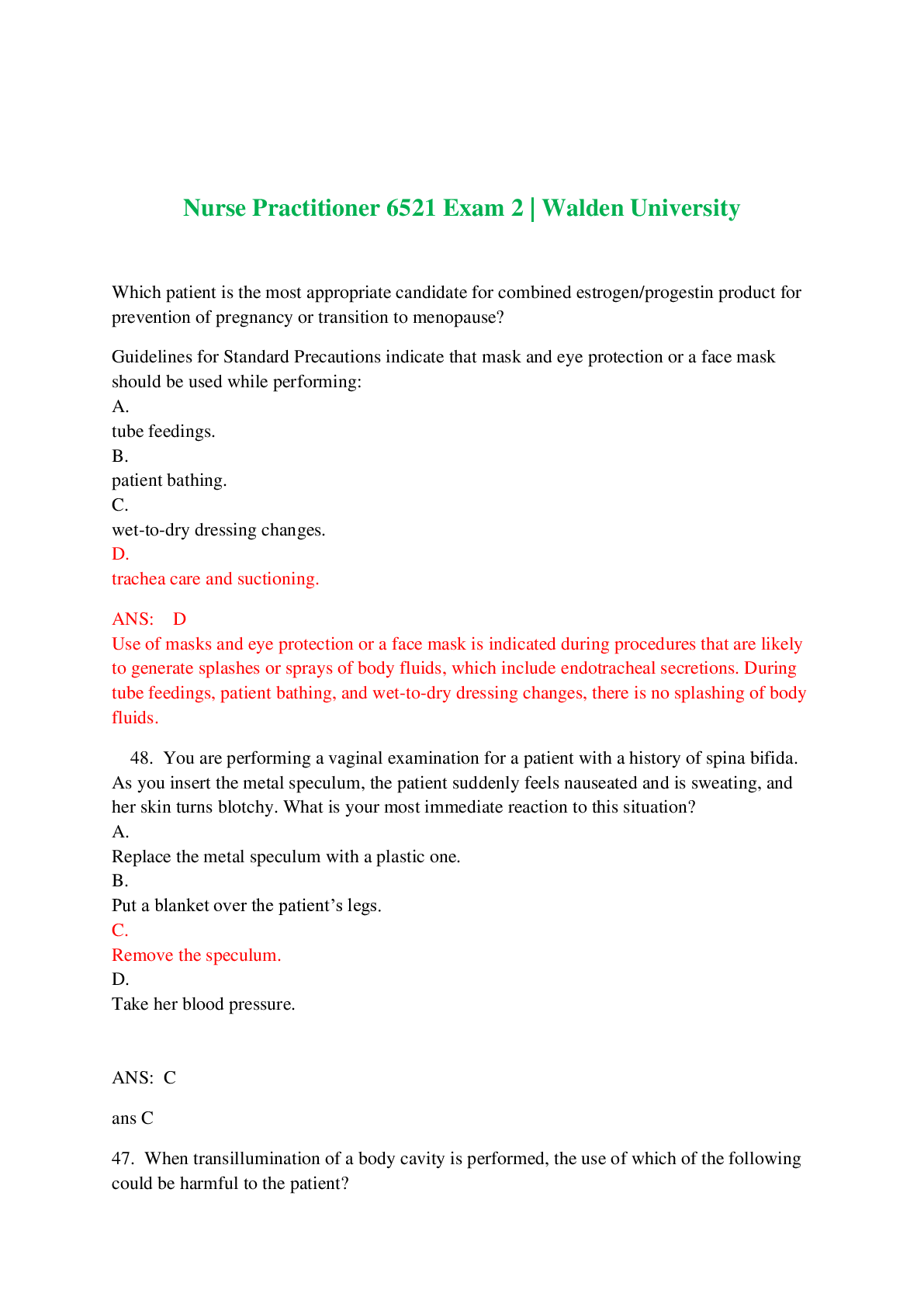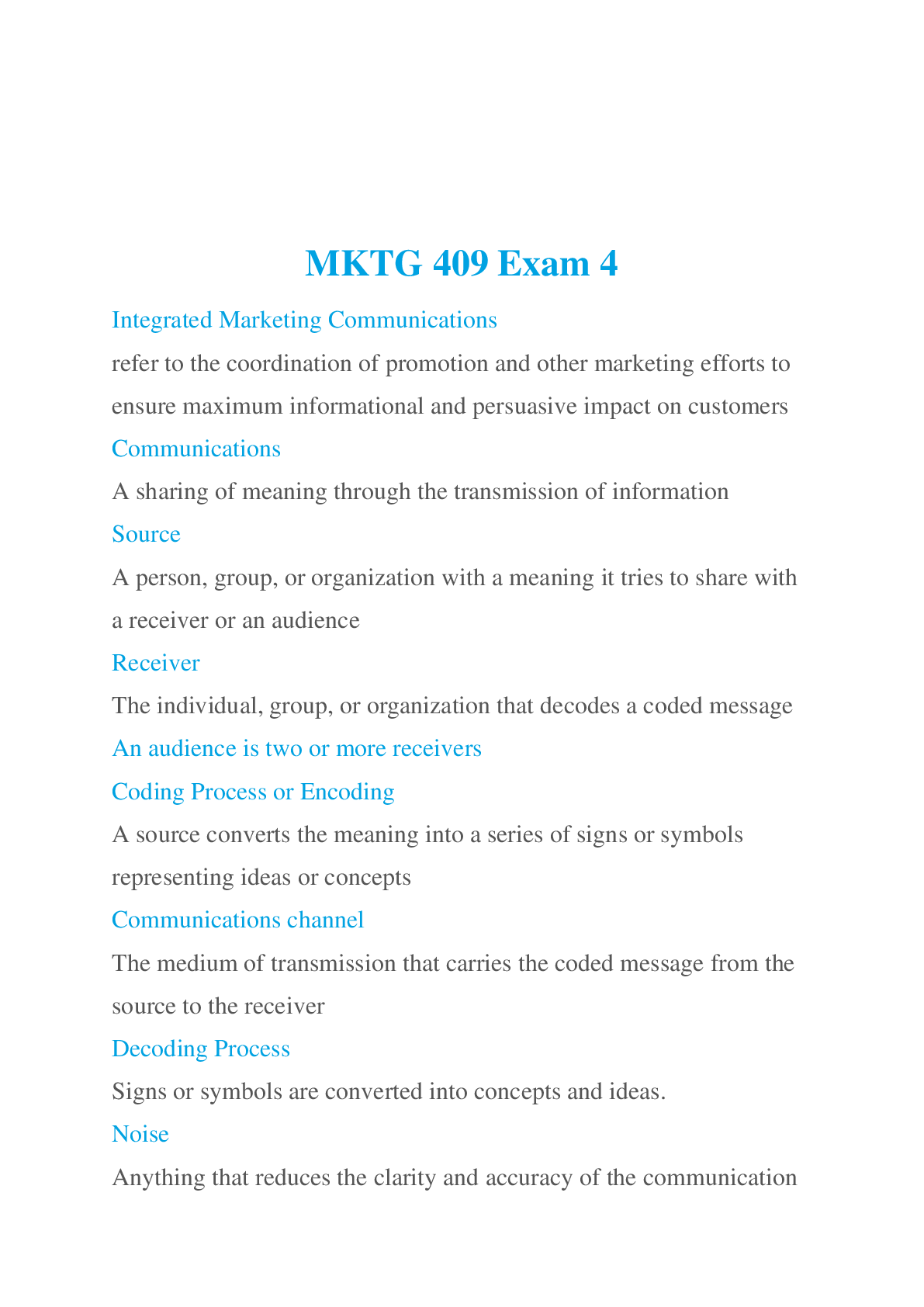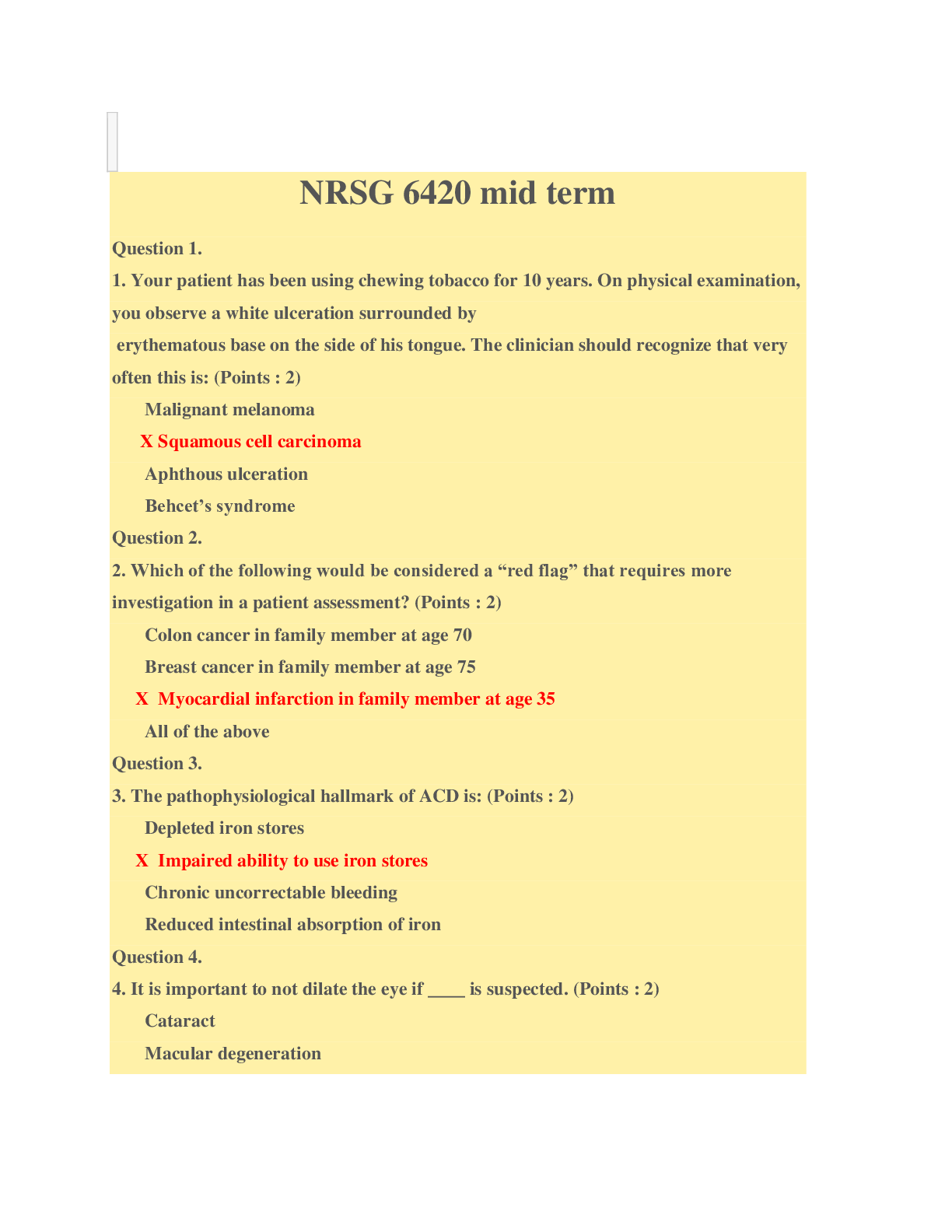MSN-FNP MSN 560Ch10.docx/RATED A
Document Content and Description Below
Chapter 10: Public Policy and the Advanced Practice Registered Nurse QUESTIONS 1. Upon moving to a new city, an advanced practice registered nurse (APRN) notices there are many county regulat... ions that expand children’s access to health-care services. Which of the following influenced the development of the regulations? Select all that apply. 2. Which of the following best explains an advanced practice registered nurse’s (APRN’s) decision to ask a legislator to support a bill that eliminates the requirement for collaborative agreements? 3. A nurse practitioner (NP) is moving to a state that requires physician supervision of all advanced practice registered nurses (APRNs) and has a strong medical lobbying group. The lobbying group’s influence represents which of the following? 4. Which requirement of the Affordable Care Act (ACA) improves access to health-care services provided by nurse practitioners? 1. An advanced practice registered nurse (APRN) is talking with a legislator about the need for a primary care clinic in an underserved area. Which of the following points should the APRN include to gain the legislator’s support? Select all that apply. 1. Access to a regular primary care provider improves chronic disease management. 2. Primary care reduces costs related to complications of untreated health conditions. 3. APRNs are educated to provide the same level of care as primary care physicians. 4. Direct reimbursement of APRNs by third-party payers reduces costs to the state. 5. Improved access to care enables APRNs to address environmental causes of disease. Answer: 6. An advanced practice registered nurse (APRN) working in a primary care clinic identifies the need for an additional health-care provider. Which of the following indicates the reason the APRN recommends hiring a nurse practitioner (NP) over other providers? 1. NPs are reimbursed at a higher rate. 2. NPs have a broader scope of practice. 3. NPs expand access to care at a lower cost. 4. NPs’ malpractice insurance is less expensive. Answer: 7. A nurse practitioner (NP) identifies advanced practice registered nurses (APRNs) in the state have reduced practice authority. The NP recognizes full practice authority includes which of the following? Select all that apply. 1. Title recognition 2. Prescriptive authority 3. Physician supervision 4. Collaborative agreement 5. Ability to diagnose patients Answer: 8. An advanced practice registered nurse (APRN) is attending a provider roundtable to discuss the Centers for Medicare and Medicaid Services’ (CMS’s) proposed changes in reimbursement policies. Which of the following indicates the APRN understands that participation in the discussion is essential? 1. APRNs are morally obligated to protect the health of the public. 2. Health-care policies impact APRN practice and quality of patient care. 3. The American Nurses Association (ANA) Code of Ethics requires nurses to advocate for health policies. 4. APRNs are responsible for setting health-care policies in practice settings. Answer: 9. Collaborative agreements for advanced practice registered nurses (APRNs) limit which of the following? 1. Political competence 2. Self-governing licensure 3. Reimbursement from third-party payers 4. Accreditation of advanced practice nursing programs Answer: 10. Which of the following may limit a nurse practitioner’s (NP’s) ability to establish a practice? 1. Scope of practice 2. Reimbursement policies 3. Accreditation requirements 4. Access to sufficient patient volume Answer: ANSWERS AND RATIONALES 1. Upon moving to a new city, an advanced practice registered nurse (APRN) notices there are many county regulations that expand children’s access to health-care services. Which of the following influenced the development of the regulations? Select all that apply. 1. A significant percentage of children in the county lacked health insurance. 2. Community members developed policies to provide accessible health care. 3. The incidence of vaccine-preventable illness among children was increasing. 4. Key stakeholders and policy makers viewed children as a vulnerable population. 5. The county board held a town hall meeting to discuss children’s health-care services. Answer: 1, 3, 4, 5 Pages: 1–2 Feedback 1. This is correct. Public policy is about communities trying to achieve something as a community. 2. This is incorrect. Public policy is made in the legislative, executive, or judicial branches of government, at either the state or federal level, within the jurisdiction of those entities. 3. This is correct. Public policy is for the good and/or protection of the community. Access to health care for children and requiring vaccines increase immunization rates. 4. This is correct. Policy development reflects the values of those making the policy. 5. This is correct. Public policy is about communities trying to achieve something. A component of the policy making process is the formulation of the problem and the identification of viable solutions. 2. Which of the following best explains an advanced practice registered nurse’s (APRN’s) decision to ask a legislator to support a bill that eliminates the requirement for collaborative agreements? 1. Limited scope of practice 2. Obligation to social contract 3. Responsibility to lead others 4. Ability to influence health policy Answer: 4 Page: 2 Feedback 1. This is incorrect. Advanced practice registered nurses (APRNs) recognize the responsibility to contribute to the development of health policy through political action. 2. This is incorrect. Advanced practice registered nurses (APRNs) recognize the responsibility to contribute to the development of health policy through political action. 3. This is incorrect. Advanced practice registered nurses (APRNs) recognize the responsibility to contribute to the development of health policy through political action. 4. This is correct. Advanced practice registered nurses (APRNs) recognize the responsibility to contribute to the development of health policy through political action. 3. A nurse practitioner (NP) is moving to a state that requires physician supervision of all advanced practice registered nurses (APRNs) and has a strong medical lobbying group. The lobbying group’s influence represents which of the following? 1. Barriers to independent practice 2. Physician resistance to APRN autonomy 3. Effect of political processes on health-care policy 4. Legislators’ lack of understanding of APRN roles Answer: 4 Page: 6 Feedback 1. This is incorrect. The process of health policy development includes the ability to influence policy makers and influences the delivery of care. 2. This is incorrect. The process of health policy development includes the ability to influence policy makers and influences the delivery of care. 3. This is incorrect. The process of health policy development includes the ability to influence policy makers and influences the delivery of care. 4. This is correct. The process of health policy development includes the ability to influence policy makers and influences the delivery of care. 4. Which requirement of the Affordable Care Act (ACA) improves access to health-care services provided by nurse practitioners (NPs)? 1. Face-to-face certification 2. Medicare reimbursement 3. Collaborative agreements 4. Nondiscrimination provision Answer: 4 Page: 11 Feedback 1. This is incorrect. Though advanced practice registered nurses (APRNs) have been authorized Part B Medicare providers since 1998, patients needing home health-care services must have a physician to certify the APRN has conducted the required face-to-face certification examination. 2. This is incorrect. Advanced practice registered nurses (APRNs) have been recognized Part B Medicare providers since 1998. 3. This is incorrect. The Affordable Care Act (ACA) does not mandate collaborative agreements. Each state legislates whether APRNs must have a collaborative agreement, which limits APRNs’ ability to practice to the full extent of their preparation. 4. This is correct. The nondiscrimination provision of the Affordable Care Act (ACA) acknowledged advanced practice registered nurses (APRNs) as primary care providers. 5. An advanced practice registered nurse (APRN) is talking with a legislator about the need for a primary care clinic in an underserved area. Which of the following points should the APRN include to gain the legislator’s support? Select all that apply. 1. Access to a regular primary care provider improves chronic disease management. 2. Primary care reduces costs related to complications of untreated health conditions. 3. APRNs are educated to provide the same level of care as primary care physicians. 4. Direct reimbursement of APRNs by third-party payers reduces costs to the state. 5. Improved access to care enables APRNs to address environmental causes of disease. Answer: 1, 2, 5 Pages: 9–12 Feedback 1. This is correct. Advanced practice registered nurses (APRNs) increase availability of primary care, which is associated with more effective provision of preventive services and better management of chronic disease. 2. This is correct. Advanced practice registered nurses (APRNs) increase availability of primary care, which is associated with more effective provision of preventive services and better management of chronic disease. 3. This is incorrect. Advanced practice registered nurses (APRNs) are mid-level care providers and practice within the limits of their nurse practice act. 4. This is incorrect. Though advanced practice registered nurses (APRNs) are recognized as qualified health-care providers, differences in the reimbursement and coverage policies, restrictions within states and policies related to direct reimbursement, and supervisory requirements by another health-care provider create challenges in reimbursement. 5. This is correct. Advanced practice registered nurses (APRNs) increase access to care for underserved populations and are educated to address social, economic, and environmental factors that influence health. 6. An advanced practice registered nurse (APRN) working in a primary care clinic identifies the need for an additional health-care provider. Which of the following indicates the reason the APRN recommends hiring a nurse practitioner (NP) over other providers? 1. NPs are reimbursed at a higher rate. 2. NPs have a broader scope of practice. 3. NPs expand access to care at a lower cost. 4. NPs’ malpractice insurance is less expensive. Answer: 3 Page: 9 Feedback 1. This is incorrect. Increased use of advanced practice registered nurses (APRNs) expands the availability of health care at a lower price. 2. This is incorrect. Increased use of advanced practice registered nurses (APRNs) expands the availability of health care at a lower price. 3. This is correct. Increased use of advanced practice registered nurses (APRNs) expands the availability of health care at a lower price. 4. This is incorrect. Increased use of advanced practice registered nurses (APRNs) expands the availability of health care at a lower price. 7. A nurse practitioner (NP) identifies advanced practice registered nurses (APRNs) in the state have reduced practice authority. The NP recognizes full practice authority includes which of the following? Select all that apply. 1. Title recognition 2. Prescriptive authority 3. Physician supervision 4. Collaborative agreement 5. Ability to diagnose patients Answer: 2, 5 Page: 13 Feedback 1. This is incorrect. A full practice license allows the advanced practice registered nurse (APRN) to evaluate patients, diagnose, order and interpret diagnostic tests, and initiate and manage treatments, including prescribing medications. 2. This is correct. The right to full practice is under the exclusive licensure authority of the state board of nursing, not a regulated collaborative agreement or supervision by another health discipline. A full practice license allows the advanced practice registered nurse (APRN) to evaluate patients, diagnose, order and interpret diagnostic tests, and initiate and manage treatment, including prescribing medications. 3. This is incorrect. The right to full practice is under the exclusive licensure authority of the state board of nursing, not a regulated collaborative agreement or supervision by another health discipline. A full practice license allows the advanced practice registered nurse (APRN) to evaluate patients, diagnose, order and interpret diagnostic tests, and initiate and manage treatment, including prescribing medications. 4. This is incorrect. The right to full practice is under the exclusive licensure authority of the state board of nursing, not a regulated collaborative agreement or supervision by another health discipline. A full practice license allows the advanced practice registered nurse (APRN) to evaluate patients, diagnose, order and interpret diagnostic tests, and initiate and manage treatments, including prescribing medications. 5. This is correct. A full practice license allows the advanced practice registered nurse (APRN) to evaluate patients, diagnose, order and interpret diagnostic tests, and initiate and manage treatments, including prescribing medications. 8. An advanced practice registered nurse (APRN) is attending a provider roundtable to discuss the Centers for Medicare and Medicaid Services’s (CMS’s) proposed changes in reimbursement policies. Which of the following indicates the APRN understands that participation in the discussion is essential? 1. APRNs are morally obligated to protect the health of the public. 2. Health-care policies impact APRN practice and quality of patient care. 3. The American Nurses Association (ANA) Code of Ethics requires nurses to advocate for health policies. 4. APRNs are responsible for setting health-care policies in practice settings. Answer: 2 Page: 5 Feedback 1. This is incorrect. Advanced practice registered nurses (APRNs) must participate in health policy making processes to ensure their input regarding the effect of legislation on APRN practice, patient care, and other health-care issues is provided and heard. 2. This is correct. Advanced practice registered nurses (APRNs) must participate in health policy making processes to ensure their input regarding the effect of legislation on APRN practice, patient care, and other health-care issues is provided and heard. 3. This is incorrect. Advanced practice registered nurses (APRNs) must participate in health policy making processes to ensure their input regarding the effect of legislation on APRN practice, patient care, and other health-care issues is provided and heard. 4. This is incorrect. Advanced practice registered nurses (APRNs) must participate in health policy making processes to ensure their input regarding the effect of legislation on APRN practice, patient care, and other health-care issues is provided and heard. 9. Collaborative agreements for advanced practice registered nurses (APRNs) limit which of the following? 1. Political competence 2. Self-governing licensure 3. Reimbursement from third-party payers 4. Accreditation of advanced practice nursing programs Answer: 2 Page: 14 Feedback 1. This is incorrect. Collaborative agreements directly limit the advanced practice registered nurse’s (APRN’s) ability to have a self-governing license. 2. This is correct. Collaborative agreements directly limit the advanced practice registered nurse’s (APRN’s) ability to have a self-governing license. 3. This is incorrect. Collaborative agreements directly limit the advanced practice registered nurse’s (APRN’s) ability to have a self-governing license. 4. This is incorrect. Collaborative agreements directly limit the advanced practice registered nurse’s (APRN’s) ability to have a self-governing license. 10. Which of the following may limit a nurse practitioner’s (NP’s) ability to establish a practice? 1. Scope of practice 2. Reimbursement policies 3. Accreditation requirements 4. Access to sufficient patient volume Answer: 2 Page: 15 Feedback 1. This is incorrect. Advanced practice registered nurse (APRN) practice increases accessibility for patient populations. 2. This is correct. Full practice authority allows for independent practice in the state. 3. This is incorrect. Accreditation requirements focus on nursing and certification programs. 4. This is incorrect. Reimbursement policies make it difficult for nurse practitioners (NPs) to serve as primary care providers (PCPs) because of differences in coverage policies, state regulatory restrictions, and supervisory requirements by another health-care provider. [Show More]
Last updated: 2 years ago
Preview 1 out of 8 pages
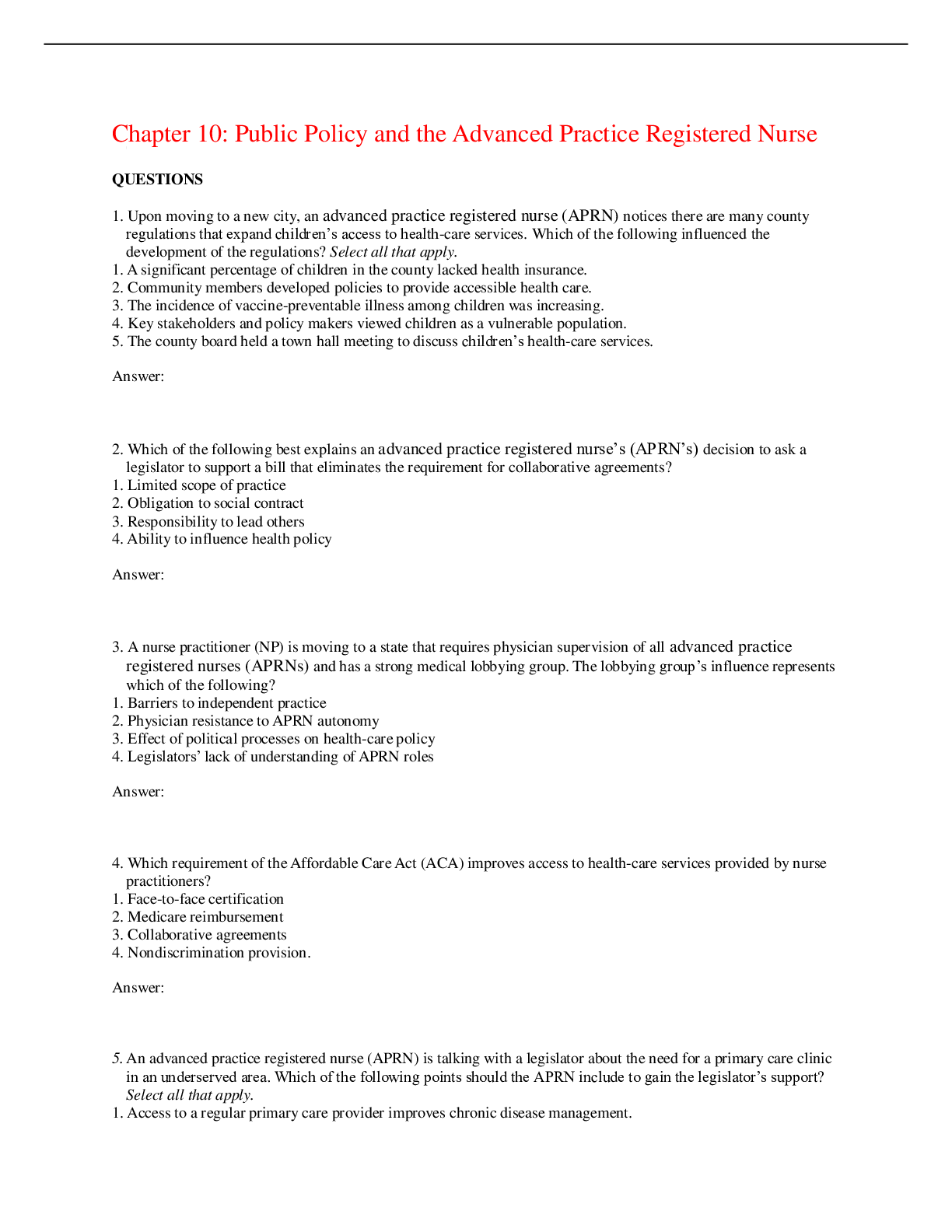
Buy this document to get the full access instantly
Instant Download Access after purchase
Buy NowInstant download
We Accept:

Reviews( 0 )
$15.00
Can't find what you want? Try our AI powered Search
Document information
Connected school, study & course
About the document
Uploaded On
Jul 24, 2021
Number of pages
8
Written in
Additional information
This document has been written for:
Uploaded
Jul 24, 2021
Downloads
0
Views
72


